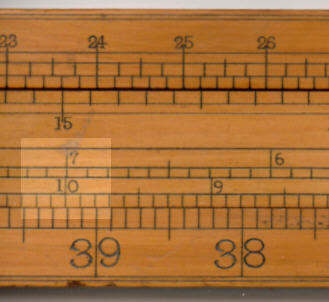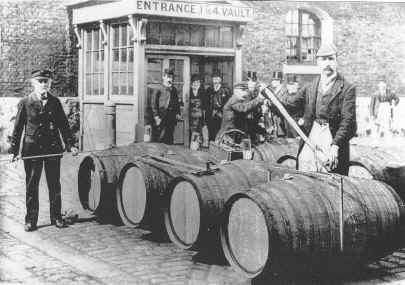1. This rule was probably made for Customs and Excise in Britain who, among other functions, levy the duty on alcoholic drinks. On the side it is stamped "Customs and Excise" and has reference numbers DF43 and F6. This was probably an official serial number.
2. This rule was designed to measure the content of a cask (barrel) whether full or partly full.
3. It was provided with a dip-stick which is 40" long from the brass plate to the end and which is marked in inches and 1/10 of an inch. The brass plate was fixed precisely and had to be placed against a metal plate on the cask to ensure accuracy.
4. On one side the scales are:
Upper Stock: Two cycles of logarithms from 10 to 1000, marked A
Upper Slide: Two cycles of logarithms from 10 to 1000, marked B
Lower Slide: Two cycles of logarithms from 1 to 100, marked C
Lower stock: A four cycle scale which is not a standard logarithmic scale. This scale is
marked "Seg Ly". (Casks were considered as of four types: middle frustum of a
spheroid, middle frustum of a parabolic spindle, two equal frustum of a paraboloid united
at their bases, two equal conic frustum united at their bases. A particular problem, known
as ullaging, was to measure the content when a caskl was not full. Casks could be
"ullaged" standing or lying. ).
On the other side the scales are:
Upper stock: Logarithmic scale from 17 to 300. Unmarked.
Upper slide: Scale from 14 to 64. Unmarked with a gauge point at 1879 which is used for
British Imperial gallons. The gauge point is the black triangle visible on the
"detail" image.
Lower slide: two short scales (12" long). This are on the upper image headed
"detail" to the left of the pointer.
From 8.1 to 0 marked SPHLn
From 11.5 to 0, unmarked.
Lower stock a scale of inches and 1/10 of an inch.
5. As can be seen from the side view the rule has two "pointers". These were used to measure the diameter of a cask. They are set so that when the rule is closed the minimum distance is 2 inches. This is to allow for the shape of the points which in turn was designed to be able to fit into the head of the cask.
6. The scales were used as follows.
To get the volume of the cask when full:
- Measure the diameter of the cask at the "head" (one end) and the "bung" middle and the length of the cask.
- The effective mean diameter was equal to the head diameter plus 0.7 times the difference between the bung and head diameters (this only applied casks of the 1st type). The figure shows part of the two small scales. As can be seen values on the upper one are 0.7 times the values of the lower one.
- Set the gauge mark on the slide against the length of the cask and read the volume in gallons against the effective diameter on the stock.
To get the ullage (contents when partly full).
- Set the bung diameter on the C scale against the 100 mark on the lower (i.e. "Seg Ly" scale).
- Against the wet depth on the C scale read an intermediate value on the lower scale. This value is the percentage of the full capacity.
- Set the full capacity (as calculated above) on the B scale against the 100 on the A scale. Read the ullage on the B scale against the intermediate value on the A scale.
On this rule this calculation can only be performed when the cask is lying down.
7. The picture below, showing use of some of the items shown here, was published in 1896.
8. For another rule which can perform calculations for casks both lying and standing see here.
9. For more information on how such rules were used see here.




